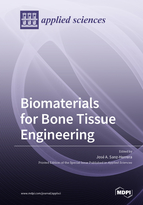Biomaterials for Bone Tissue Engineering
A special issue of Applied Sciences (ISSN 2076-3417). This special issue belongs to the section "Applied Biosciences and Bioengineering".
Deadline for manuscript submissions: closed (31 August 2019) | Viewed by 62191
Special Issue Editor
Special Issue Information
Dear Colleagues,
Applied Sciences invites submissions to this Special Issue on the broad field of Biomaterials for Bone Tissue Engineering.
Bone tissue engineering field aims at the development of artificial bone substitutes that restore (partially or totally) the natural regeneration capability of bone tissue lost under circumstances of injury; significant defects; or diseases, such as osteoporosis. In this context, biomaterials are the keystone of the methodology. Historically, biomaterials for bone tissue engineering have evolved from biocompatible materials that mimic the physic-chemical environment of bone tissue, as well as the macroscopic and microscopic features of bone tissue, to a new generation of materials that actively interact with the physiological environment, accelerating tissue growth. On the other hand, sophisticated fabrication protocols and procedures have been implemented accordingly to biomaterial characteristics; 3D bioprinting and biofabrication are emerging areas of development in this field.
In this Special Issue, we encourage submissions of cutting-edge original research works in this field. We expect to receive contributions from different areas of multidisciplinar research, including – but not restricted to—the synthesis, fabrication, characterization, and experimentation of biomaterials in bone tissue engineering applications. Modeling and simulation of biomaterials research papers are also expected in order to emphasize the importance of this tool in the design stage, as well as virtual testing of complex phenomena that takes place in these applications. Comprehensive review and survey papers are also welcome in this Special Issue.
Prof. Dr. José A. Sanz-Herrera
Guest Editor
Manuscript Submission Information
Manuscripts should be submitted online at www.mdpi.com by registering and logging in to this website. Once you are registered, click here to go to the submission form. Manuscripts can be submitted until the deadline. All submissions that pass pre-check are peer-reviewed. Accepted papers will be published continuously in the journal (as soon as accepted) and will be listed together on the special issue website. Research articles, review articles as well as short communications are invited. For planned papers, a title and short abstract (about 100 words) can be sent to the Editorial Office for announcement on this website.
Submitted manuscripts should not have been published previously, nor be under consideration for publication elsewhere (except conference proceedings papers). All manuscripts are thoroughly refereed through a single-blind peer-review process. A guide for authors and other relevant information for submission of manuscripts is available on the Instructions for Authors page. Applied Sciences is an international peer-reviewed open access semimonthly journal published by MDPI.
Please visit the Instructions for Authors page before submitting a manuscript. The Article Processing Charge (APC) for publication in this open access journal is 2400 CHF (Swiss Francs). Submitted papers should be well formatted and use good English. Authors may use MDPI's English editing service prior to publication or during author revisions.
Keywords
- synthesis, characterization, and modeling of biomaterials
- cellular-matrix interactions
- bone tissue engineering






